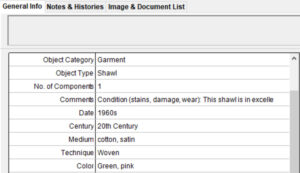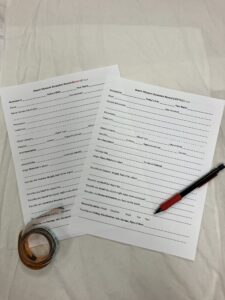Collections Database Coordinator Gabrielle Friesen explains her role in her own words.
As collections database coordinator for the Colorado State University Avenir Museum of Design and Merchandising, I manage the digital data for each object in the collection. The Avenir Museum collection includes global textiles, designer clothing, patterns and swatch books, and interior design objects. Each piece in the collection comes with its own discrete data. Building a data management system today is an investment in both the collection’s future, and in the history it represents.
What is ‘provenance?’
When bringing a new piece into the collection the museum records its provenance, or history of the piece: who owned it, for how long, and how they acquired it. The core characteristics of a piece are also included in a description. As a collection used for research, having as much information as possible is important for understanding the object.
Traditionally, the information was recorded on paper. A digital database augments the paper record, and most museums continue to use both a physical and digital database. This duplication provides a backup in a worst-case scenario. If the paper records are lost, say in a flood or fire, the data attached to the collection pieces are still safe in the digital database. If the digital database suffers catastrophic data loss, the paper records can reconstruct the database.
Without its attached data, an object may be beautiful, but it lacks context. The collections manager and curator can research missing data like the year a piece was designed or who the creator was. But there are other times that the data could not easily be reconstructed after a loss, such as donor information, point of origin, or the memories that fill out the story of an article of clothing. The maker’s inspiration sources, parties a piece was worn to, the grandparent who gifted it, the smell of the piece the first time it was worn — these contextual elements enliven and enrich our understanding of a piece and its past. Recording data is critical to maintaining the narrative of the piece’s life before it came to the museum and enriches the experience of those who discover it through research or exhibition. 
Avenir inventory
For the last two years, the talented and dedicated volunteers at the Avenir have been working on an inventory of the 20,000+ pieces in the collection, complete with storage locations and descriptions of each piece. Roughly 75% of the collection has been inventoried to date. This work is being done in an Excel spreadsheet. I am transferring the data from Excel to our digital database on the platform EmbARK. Having the information available in the database allows it to be searchable. This will be invaluable to the Avenir team in curating exhibitions, planning classes, and pulling objects for student research.
Once the database is completed, I can start the next big digital project for the Avenir: an online and searchable version of the Avenir collection. Even if a piece is not on exhibit, it will still be accessible via the online collection. The online collection will increase accessibility for students, researchers, and the public. It will also help the Avenir to better tell the thousands of stories stored in the collection.
The Avenir Museum is in the Department of Design and Merchandising, part of CSU’s College of Health and Human Sciences.
